Guardian Metal Resources PLC Announces Tempiute Mine Project - Geological Update
Rhea-AI Summary
Guardian Metal Resources has announced significant developments at its Tempiute Tungsten Project in Nevada. Independent expert Dr. Lawrence Carter's assessment revealed extensive tungsten-rich skarn mineralization across the project area, connected to two quartz monzonite stocks.
Key findings include the discovery of multiple new tungsten-rich zones, leading to the staking of 29 new BLM Lode Mining Claims, effectively doubling the project's footprint. The team identified several "truck-ready" historical ore stockpiles and discovered porphyry-style stockwork veining containing molybdenite and copper mineralization.
A new satellite tungsten-skarn system, named Worthington, was identified 34 km north of Tempiute, with historical literature suggesting approximately 0.4% WO3 content. The company has staked two claims over this system, expanding its strategic position in Nevada's tungsten resources.
Positive
- Project footprint doubled through strategic staking of 29 new mining claims
- Discovery of multiple new tungsten-rich skarn zones previously unexplored
- Identification of 'truck-ready' historical ore stockpiles that could provide immediate revenue potential
- Discovery of porphyry-style mineralization suggesting potential for larger-scale mining operations
- New satellite tungsten-skarn system (Worthington) identified and claimed, expanding company's resource base
- Project could become the only domestic primary source of tungsten in the USA
Negative
- Historical mine operations were halted due to tungsten market flooding, indicating market vulnerability
- Project currently in early exploration phase with no defined resource estimates
- No current production or revenue generation
- Historical mining limited to high-grade skarn mineralization, leaving uncertainty about broader economic viability
News Market Reaction 1 Alert
On the day this news was published, GMTLF declined 2.95%, reflecting a moderate negative market reaction.
Data tracked by StockTitan Argus on the day of publication.
Extensive Skarn & Porphyry Mineralisation Identified, Project Footprint Doubled by Staking
LONDON, UK / ACCESS Newswire / April 30, 2025 / Guardian Metal Resources plc (LON:GMET)(OTCQX:GMTLF), a strategic development and mineral exploration company focused in Nevada, USA, is pleased to announce that an independent porphyry-system expert, Dr. Lawrence Carter, has completed a positive site assessment of the recently acquired Tempiute Tungsten Project ("Tempiute" or the "Project"). Tempiute, formerly known as the Emerson Tungsten Mine, is located in south-central Nevada less than 250 miles (402 km) southeast of the Company's Pilot Mountain tungsten project.
On 27 January 2025, the Company announced the signing of an option agreement to acquire
BACKGROUND
Guardian Metal recently retained Dr Lawrence Carter, an independent porphyry-system expert, to conduct a geological field review of the Tempiute mine and surrounding area (Figure 1). Dr Carter was engaged to investigate and confirm historical geological reports of the Tempiute mine whilst also prospecting the surrounding area for further exploration potential. A high-level summary of his findings are provided herein.
HIGHLIGHTS
Extensive zones of outcropping tungsten-rich skarn mineralisation (confirmed via ultraviolet light fluorescence investigations) mapped across the entire Project area which have a direct association to two quartz monzonite stocks (causative porphyry intrusions).
Multiple new zones of tungsten-rich skarn mineralisation (garnet rich) were identified at the margins of the north quartz monzonite stock, which appear to have been little-explored. The Company has immediately staked a total of 29 new Bureau of Land Management ("BLM") Lode Mining Claims at Tempiute to cover these new target areas, significantly increasing the mineralised footprint of the Project by more than double. Maps will be made available once analytical results have been received.
Multiple zones of porphyry-style stockwork veining in altered quartz monzonite are outcropping within the southern quartz monzonite stock. Locally these zones include hypogene molybdenite mineralisation as well as secondary copper mineralisation (copper oxide and chalcocite). Seemingly overlooked by previous work, the Company has now completed claim staking to cover areas prospective for larger-scale porphyry-style mineralisation.
Numerous "truck-ready" historical ore stockpiles identified across the Project, of both skarn and massive sulphide mineralisation, including a further stockpile that was identified east of the Project area that is now covered by staking. Several samples of this material are undergoing laboratory analysis.
A new tungsten-skarn system identified and two new BLM Lode Mining Claims staked at a newly identified satellite zone to Tempiute to be named the Worthington system, generated by the Company's regional exploration campaign. Further details in relation to Worthington will be released to the market in due course.
TUNGSTEN SKARN MINERALISATION AT TEMPIUTE AND HISTORICAL MINING
Polymetallic tungsten-rich skarn mineralisation occurs in a thermally zoned, contact-metasomatic garnet-pyroxene skarn zone, separating the causative Cretaceous-aged quartz monzonite and barren limestone and hornfels. Historical mining at the Tempiute Mine (also known as the Emerson Mine) targeted the widest zones of skarn mineralisation using underground stoping. Some stopes can be viewed via glory holes at surface (Figure 1D). Previous work delineated skarn zones up to 30 m thick to be uniformly mineralised over vertical ranges of at least 400 m based on historical mine plans. Reported principal ore minerals include scheelite, sphalerite, molybdenite, chalcopyrite and galena1. Despite the historical mining activity, many zones of skarn mineralisation remain outcropping at surface, ranging from < 1 m to circa 20 m thick in outcrop, all along contact zones with the two quartz monzonite stocks.
The skarn is varied, with notable styles including banded garnet-pyroxene skarn and coarse garnet skarn, with garnets up to 1 cm in size (Figure 2). By investigation under ultraviolet ("UV") light fluorescence, scheelite and/or powellite appears more abundant in garnet rich zones and sulphides in diopside bands. Certain skarn zones are sulphide rich, with pods of sulphide minerals (predominately pyrite) up to 5 cm across (see Figure 2D). Molybdenite is locally abundant and very coarse grained, particularly near the contact between the skarn and unmineralised hornfels (Figure 3). The garnet skarn is also cut by sulphide mineralised quartz veins (see Figure 2E). Grab samples were taken at all skarn outcrops across the project to investigate the strength and variations in mineralisation.
NEW SKARN ZONES MAPPED AND STAKED AT TEMPIUTE
Dr Carter identified several new zones of outcropping garnet skarn mineralisation around the south, east and north margins of the north quartz monzonite stock (Figure 9 & 10). In outcrop, these skarn zones vary from approximately 1m to 10m in thickness. UV light investigation shows that these outcropping garnet skarns are tungsten rich (Figure 10). Numerous grab samples were taken from these zones to investigate the strength and variety of mineralisation. Some of these skarns have been historically mined on a small scale, and others are outcropping with no evidence of previous mining. No evidence for historical drill holes was found, and so it is assumed that these skarn zones are little- to un-explored.
Based on Dr Carter's findings, the Company immediately staked a total of 29 new BLM Lode Mining Claims ("claims") at Tempiute to cover the newly identified skarn zones and the areas believed to be highly prospective for porphyry-style mineralisation (see below), increasing the overall footprint of the Tempiute project area.
PORPHYRY-STYLE ALTERATION AND MINERALISATION
The polymetallic skarn mineralisation is associated with two quartz monzonite intrusions, which are both cut by porphyry dykes of similar composition. The north intrusion is coarser grained and more homogenous than the south intrusion, and is notable for zones of potassic alteration associated with quartz veins (pyrite bearing locally) (Figure 4). With the southern intrusion, proximal to the skarn zones, are multiple outcrops of quartz-sericite-pyrite ("QSP" or "phyllic") alteration associated with intense stockworks of oxidised quartz-sulphide veins (Figure 5). These stockworks are locally associated with secondary copper mineralisation (copper oxide and chalcocite) and, where less oxidised, some of the outcropping veins are molybdenite-pyrite-quartz veins (Figure 6). Small areas of gossan and massive sulphide mineralisation (Figure 7) also appear associated with the zones of stockwork veins. These outcropping mineralised stockworks are considered exciting as they highlight the potential for larger scale porphyry-style mineralisation. These zones also appear to have been overlooked by the historical work which has focused purely on the high grade skarn mineralisation and may have dismissed the potential for high-tonnage porphyry-style mineralisation. All areas were sampled to investigate the mineralisation. A proportion of the 29 new claims cover the areas believed to be highly prospective for porphyry-style mineralisation.
NUMEROUS ORE STOCKPILES
Numerous historical ore stockpiles were identified around the Project and extensively sampled (Figure 8). As the mine abruptly ceased operations in the 1980s due to flooding of the tungsten market, and the subsequently decrease in metal pricing, the operator at the time left ore stockpiled by the mill site and around the numerous mine portals. The majority of the stockpiles are easily accessible by the existing roads and therefore deemed "truck-ready" for transport to a processing facility. The majority of the stockpiles comprise banded red-green garnet skarn and coarse garnet skarn. At least one stockpile is of massive sulphide and gossanous material. The Company is exploring its potential options to process this material in the shortest timeframe possible, given that it would represent the only domestic primary source of tungsten in the USA.
SAMPLES FOR MOLYBDENITE RE-OS AGE DATING
Three samples of molybdenite, one from a porphyry-style molybdenite-pyrite-quartz vein within the south quartz monzonite and two from coarse molybdenite skarn zones, have been sent for molybdenite rhenium-osmium geochronological analysis (Re-Os dating) by Prof. David Selby at the University of Durham, UK. The data will allow the Company's geologists to better place the Tempiute geology into a regional setting, and further assist the Company's broader exploration campaign.
WORTHINGTON - NEW SATELLITE PROJECT STAKED
The Company's regional exploration programme generated a number of tungsten skarn targets to be potential satellite projects to Tempiute. Dr Carter assessed a number of these targets during his field campaign. As a result, the Company immediately staked two claims over the Worthington skarn system.
The Worthington skarn system is situated approximately 34 km north of the main Tempiute project area, in the Worthington Mountains. Similar to Tempiute, scheelite bearing garnet skarn is developed at the contact between a Cretaceous granitic stock and limestones. The skarn is outcropping and can be traced for several hundred metres along a ridge. From inspection with UV light, scheelite and/or powellite appears disseminated throughout a light green garnet-pyroxene skarn (Figure 11). Along with descriptions of scheelite and wolframite, historical literature2 estimated the skarn to contain circa
MEDIA
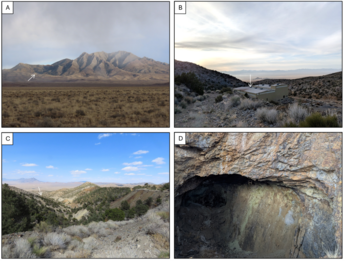
Figure 1: (A) looking east at the Tempiute Range. White arrow showing location of millsite (B), looking west above the millsite, white arrow to correlate location with A & C. (C) view from mine site looking north towards the mill site (white arrow). The skarn zone continues along the ridge at the contact between the quartz monzonite and host limestone. (D) glory hole where an open stope has reached surface. See ladder in stope for scale. The skarn zone can be seen in cross section here as circa 20-30 m thick.
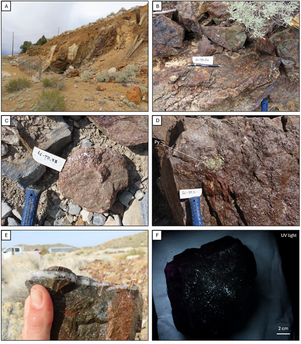
Figure 2: (A) looking north at outcropping circa 20 m thick skarn zone at the contact between intensely QSP altered quartz monzonite (right) and limestone (far left). This outcrop is above a glory hole into an open stope, the same seen in Figure 1 D. (B) example of outcropping banded garnet (red) and pyroxene (green) skarn. (C) sample of coarse garnet skarn, with garnets up to 1 cm in diameter. (D) pods of massive sulphide in garnet skarn. (E) banded skarn cut by chalcopyrite-pyrite mineralised quartz vein. (F) fluorescence under UV light of garnet skarn showing high concentration of powellite and/or scheelite. Gn = garnet, Py = pyrite, Cpy - chalcopyrite, Qtz = quartz, Px = pyroxene.
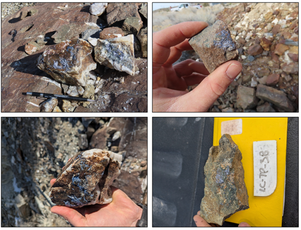
Figure 3: Examples of coarse grained molybdenite mineralisation in garnet skarn, found associated with calcite veins at and near the contact between the skarn with unmineralised hornfels.
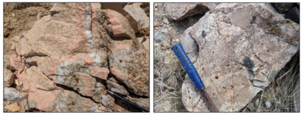
Figure 4: Quartz veins with potassic alteration halos (pink) outcropping in the north quartz monzonite stock.
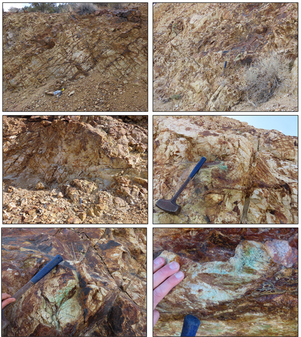
Figure 5: Examples of intense porphyry-style stockworks of quartz-sulphide veins in QSP altered quartz monzonite, from various outcrops across the south quartz monzonite stock. The stockworks are seen locally associated with secondary Cu mineralisation (Cu oxides and chalcocite).
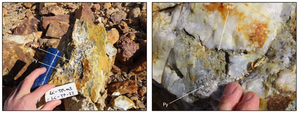
Figure 6: Examples of outcropping molybdenite-pyrite-quartz veins in the QSP altered southern quartz monzonite stock, demonstrating hypogene porphyry-style mineralisation. Mo = molybdenite, Py = pyrite, Qtz = quartz.
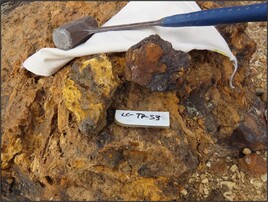
Figure 7: Sample of gossanous, massive sulphide mineralisation adjacent to outcropping stockwork quartz-sulphide veins in QSP altered quartz monzonite.
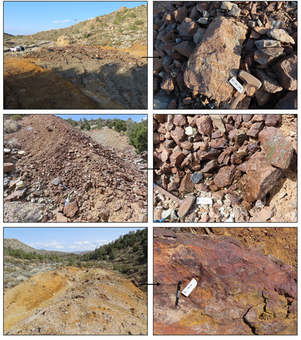
Figure 8: Examples of the numerous "truck-ready" stockpiles of garnet skarn and gossan / massive sulphide.
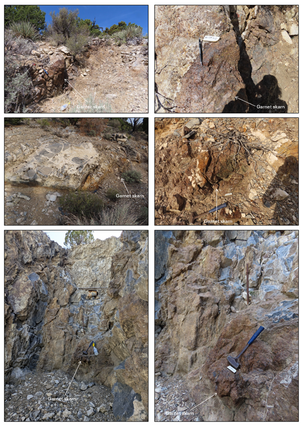
Figure 9: Field photographs of the newly identified and immediately staked garnet skarn zones around the margins of the north quartz monzonite stock. Some have been historically mined on a small scale whilst others appear untouched. No evidence of historical drilling was found and these are assumed to be effectively unexplored.
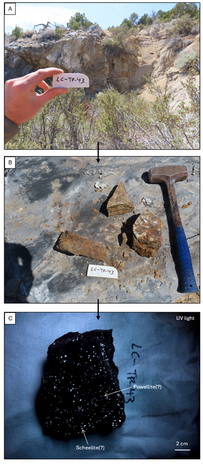
Figure 10: Outcrop to sample scale examples of a newly identified and immediately staked skarn zone, with a photograph of fluorescence under UV light showing the high concentrations of scheelite and/or powellite.
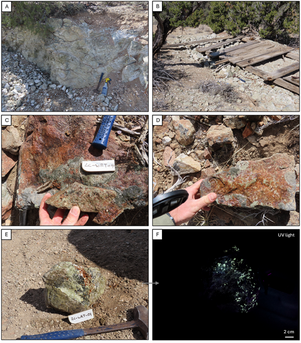
Figure 11: (A) outcropping pale green skarn at Worthington, a newly identified and claimed satellite project to Tempiute. The skarn is developed at the contact between a granite stock and limestones. (B) remnants of a historical shaft, the only evidence of historical activity at the prospect. (C to E) examples of outcropping garnet-pyroxene skarn at the Worthington system. (F) fluorescence of sample (shown in E) under UV light, indicating high concentrations of powellite and/or scheelite.
COMPETENT PERSON STATEMENT
The technical information contained in this disclosure has been read and approved by Mr Nick O'Reilly (MSc, DIC, MIMMM QMR, MAusIMM, FGS), who is a qualified geologist and acts as the Competent Person under the AIM Rules - Note for Mining and Oil & Gas Companies. Mr O'Reilly is a Principal consultant working for Mining Analyst Consulting Ltd which has been retained by Guardian Metal Resources plc to provide technical support.
REFERENCES
1Busek, P., 1967. Contact Metasomatism and Ore Deposition: Tempiute, Nevada. Economic Geology, 62, pp. 331-353.
2Tschanz, C.M. and Pampeyan, E.H., 1970. Geology and Mineral Deposits of Lincoln County, Nevada. Nevada Bureau of Mines and Geology, Bulletin 73.
This announcement contains inside information for the purposes of Article 7 of EU Regulation 596/2014 (which forms part of domestic UK law pursuant to the European Union (Withdrawal) Act 2018). The Directors of the Company are responsible for the contents of this announcement.
Forward Looking Statements
This announcement contains forward-looking statements relating to expected or anticipated future events and anticipated results that are forward-looking in nature and, as a result, are subject to certain risks and uncertainties, such as general economic, market and business conditions, competition for qualified staff, the regulatory process and actions, technical issues, new legislation, uncertainties resulting from potential delays or changes in plans, uncertainties resulting from working in a new political jurisdiction, uncertainties regarding the results of exploration, uncertainties regarding the timing and granting of prospecting rights, uncertainties regarding the timing and granting of regulatory and other third party consents and approvals, uncertainties regarding the Company's or any third party's ability to execute and implement future plans, and the occurrence of unexpected events.
Actual results achieved may vary from the information provided herein as a result of numerous known and unknown risks and uncertainties and other factors.
For further information visit www.Guardianmetalresources.com or contact the following:
Guardian Metal Resources plc Oliver Friesen (CEO) | Tel:+44 (0) 20 7583 8304 |
Cairn Financial Advisers LLP Nominated Adviser Sandy Jamieson/Jo Turner/Louise O'Driscoll | Tel: +44 20 7213 0880 |
Shard Capital Partners LLP Lead Broker Damon Heath/Erik Woolgar | Tel: +44 (0) 20 7186 9000 |
This information is provided by RNS, the news service of the London Stock Exchange. RNS is approved by the Financial Conduct Authority to act as a Primary Information Provider in the United Kingdom. Terms and conditions relating to the use and distribution of this information may apply. For further information, please contact rns@lseg.com or visit www.rns.com.
SOURCE: Guardian Metal Resources PLC
View the original press release on ACCESS Newswire









